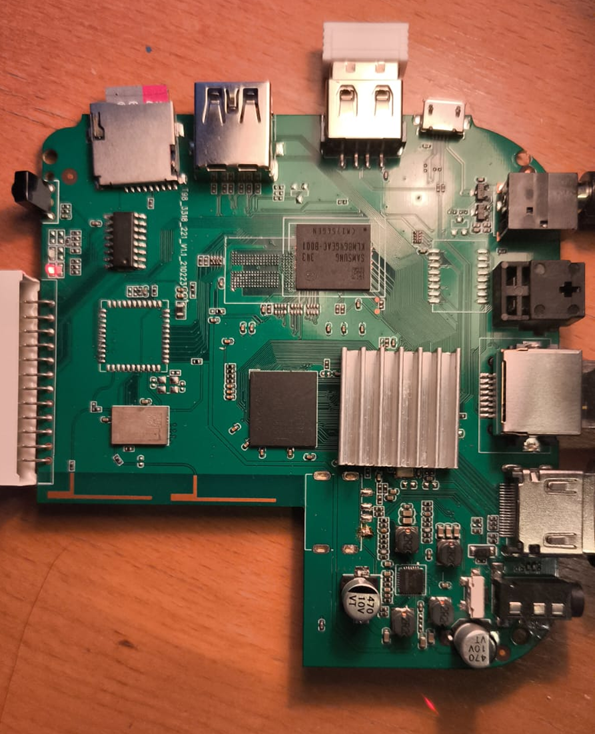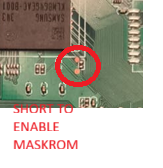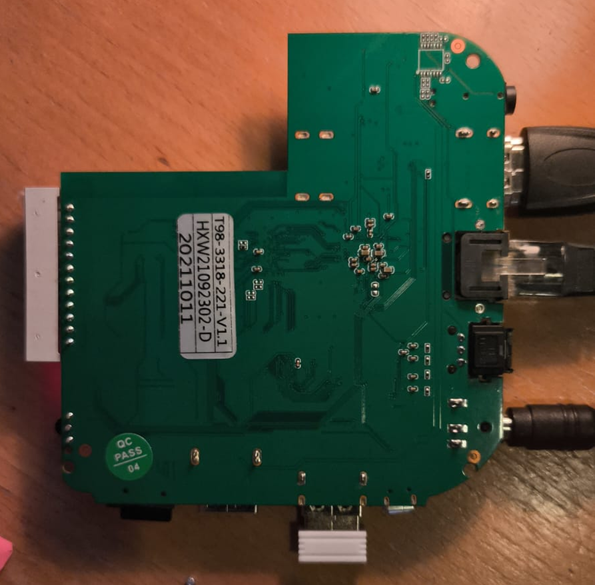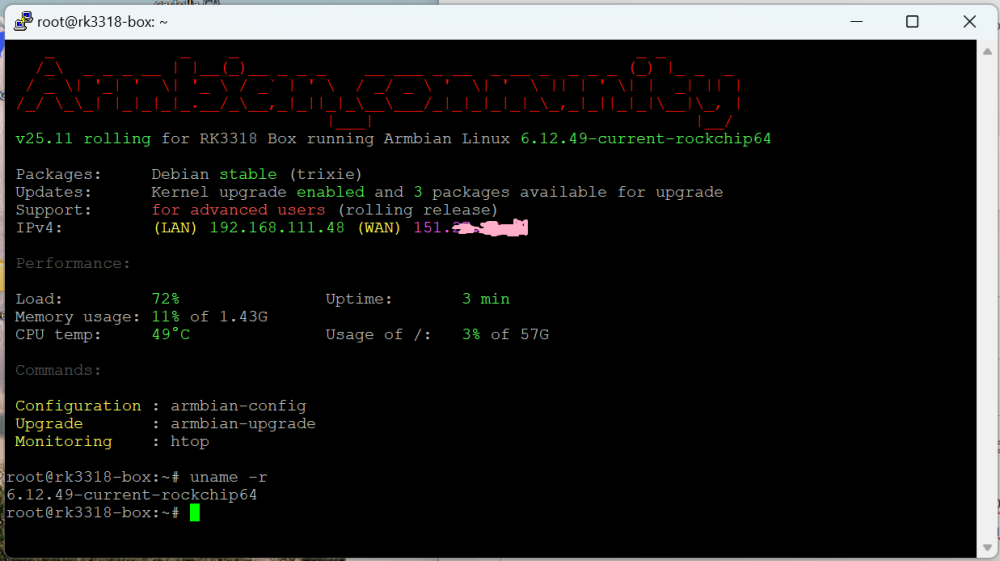Active threads
Showing topics posted in for the last 365 days.
- Past hour
-
Hardware: Orange PI 5 Plus (rk3588) Operating System: Debian Trixie (pure, except EFI boot and Armbian edge kernel) EFI Source: https://github.com/edk2-porting/edk2-rk3588 The boot messages, after a few starts (spaced apart) of the low-memory-monitor.service, say there's a failure to start it. After booting is complete, here's a screenshot of the output of: systemctl status low-memory-monitor.service This error didn't show up until I installed a number of packages. I tracked down the offending package from the Trixie repository: Package: xfsprogs Version: 6.13.0-2+b1 Size: 4774 kB Once this package was removed, the error vanished, and a repeat of the above Status command reported low-memory-monitor-service as active and okay. I also found that, while the error occurred with the Armbian edge 6.16.4 kernel, it did NOT occur with the Debian 6.16.3 kernel. Kernel With The Error (kernel source: Armbian) --------------------- Package: linux-image-edge-rockchip64 (Armbian Linux edge kernel image 6.16.4-edge-rockchip64) Version: 25.8.1 Size: 282 MB Kernel Without The Error (kernel source: trixie-backports) ------------------------ Package: linux-image-6.16.3+deb13-arm64-unsigned (Linux 6.16 for 64-bit ARMv8 machines) Version: 6.16.3-1~bpo13+1 Size: 210 MB I also briefly tried regressing the Armbian edge kernel from 25.8.1 (6.16.4) to the previously available version of 25.5.2, which was 6.16.0-rc3 (I think). The error occurred with that kernel as well.
- Today
-
@SuperKali I have the original NanoPC-T6 - purchased around 2 years ago. While it does negotiate HS400 mode, it's not stable - medium or heavy I/O activity like performing an apt upgrade or even booting will cause I/O errors to be logged by the kernel. I've just tried switching to 6.16.4-edge-rockchip64 via armbian-config. It took a few attempts to get it booted - it hung several times at "begin: running /scripts/init-bottom ... done". On the successful boot, I could see quite a few I/O errors during boot. Here's the kernel logs showing HS400 mode was negotiated along with the I/O errors: root@nanopct6:~# dmesg | grep mmc [ 1.776595] mmc0: SDHCI controller on fe2e0000.mmc [fe2e0000.mmc] using ADMA [ 1.875696] mmc0: new HS400 Enhanced strobe MMC card at address 0001 [ 1.876758] mmcblk0: mmc0:0001 A3A444 230 GiB [ 1.880737] mmcblk0: p1 [ 1.881457] mmcblk0boot0: mmc0:0001 A3A444 4.00 MiB [ 1.883682] mmcblk0boot1: mmc0:0001 A3A444 4.00 MiB [ 1.885887] mmcblk0rpmb: mmc0:0001 A3A444 4.00 MiB, chardev (243:0) [ 2.191107] dwmmc_rockchip fe2c0000.mmc: IDMAC supports 32-bit address mode. [ 2.191125] dwmmc_rockchip fe2c0000.mmc: Using internal DMA controller. [ 2.191132] dwmmc_rockchip fe2c0000.mmc: Version ID is 270a [ 2.191158] dwmmc_rockchip fe2c0000.mmc: DW MMC controller at irq 122,32 bit host data width,256 deep fifo [ 2.191894] dwmmc_rockchip fe2c0000.mmc: Got CD GPIO [ 2.204956] mmc_host mmc1: Bus speed (slot 0) = 400000Hz (slot req 400000Hz, actual 400000HZ div = 0) [ 4.370210] EXT4-fs (mmcblk0p1): mounted filesystem a4f48be8-f667-4cac-a9a7-61ce8f9035d1 ro with ordered data mode. Quota mode: none. [ 5.796770] I/O error, dev mmcblk0, sector 261857 op 0x0:(READ) flags 0x80700 phys_seg 1 prio class 2 [ 5.819713] I/O error, dev mmcblk0, sector 261857 op 0x0:(READ) flags 0x0 phys_seg 1 prio class 2 [ 5.848297] I/O error, dev mmcblk0, sector 261857 op 0x0:(READ) flags 0x0 phys_seg 1 prio class 2 [ 7.379796] I/O error, dev mmcblk0, sector 221648 op 0x0:(READ) flags 0x80700 phys_seg 2 prio class 2 [ 7.538332] I/O error, dev mmcblk0, sector 183451920 op 0x0:(READ) flags 0x80700 phys_seg 5 prio class 2 [ 7.727265] I/O error, dev mmcblk0, sector 182816073 op 0x0:(READ) flags 0x80700 phys_seg 4 prio class 2 [ 7.889544] I/O error, dev mmcblk0, sector 182816073 op 0x0:(READ) flags 0x0 phys_seg 1 prio class 2 [ 8.181746] I/O error, dev mmcblk0, sector 182816073 op 0x0:(READ) flags 0x0 phys_seg 1 prio class 2 [ 8.325932] I/O error, dev mmcblk0, sector 182816073 op 0x0:(READ) flags 0x0 phys_seg 1 prio class 2 [ 8.865460] I/O error, dev mmcblk0, sector 189262696 op 0x0:(READ) flags 0x80700 phys_seg 5 prio class 2 [ 9.097362] EXT4-fs (mmcblk0p1): re-mounted a4f48be8-f667-4cac-a9a7-61ce8f9035d1 r/w. [ 11.883700] I/O error, dev mmcblk0, sector 189160184 op 0x0:(READ) flags 0x80700 phys_seg 3 prio class 2 [ 13.327491] I/O error, dev mmcblk0, sector 189233040 op 0x0:(READ) flags 0x80700 phys_seg 1 prio class 2 [ 13.534473] I/O error, dev mmcblk0, sector 189247499 op 0x0:(READ) flags 0x80700 phys_seg 1 prio class 2 [ 14.342633] I/O error, dev mmcblk0, sector 214158 op 0x0:(READ) flags 0x80700 phys_seg 2 prio class 2 [ 16.773905] I/O error, dev mmcblk0, sector 189145145 op 0x0:(READ) flags 0x80700 phys_seg 2 prio class 2 [ 16.943465] I/O error, dev mmcblk0, sector 189142964 op 0x0:(READ) flags 0x80700 phys_seg 2 prio class 2 [ 16.946051] I/O error, dev mmcblk0, sector 189142966 op 0x0:(READ) flags 0x80700 phys_seg 2 prio class 2 [ 17.923621] I/O error, dev mmcblk0, sector 182816073 op 0x0:(READ) flags 0x0 phys_seg 1 prio class 2 [ 17.943695] I/O error, dev mmcblk0, sector 182816073 op 0x0:(READ) flags 0x0 phys_seg 1 prio class 2 Once booted it's pretty easy to trigger on-demand with a lightweight fio test: fio --filename=fio.bin --size=1GB --direct=1 --rw=randrw --bs=64k --ioengine=libaio --iodepth=1 --runtime=120 --numjobs=1 --time_based --group_reporting --name=rw --eta-newline=1 rw: (g=0): rw=randrw, bs=(R) 64.0KiB-64.0KiB, (W) 64.0KiB-64.0KiB, (T) 64.0KiB-64.0KiB, ioengine=libaio, iodepth=1 fio-3.36 Starting 1 process fio: io_u error on file fio.bin: Input/output error: read offset=705167360, buflen=65536 fio: pid=2237, err=5/file:io_u.c:1896, func=io_u error, error=Input/output error (with similar I/O errors logged in to the kernel logs at the same time). When running in HS200 mode using the DTB provided by @usual user, I can't trigger any I/O errors - no matter how hard I push it via fio. I then tried switching to the vendor kernel ("linux-image-vendor-rk35xx=25.8.1 v6.1.115"). That did result in a bunch of I/O errors being logged (including on the apt output), and when rebooting in to the new kernel there was no output whatsoever (I assume it got corrupted and couldn't boot). So instead, I booted back off the SD card and switched that to the same vendor kernel - which did work. And in better news, I was able to mount the MMC partition from there and run the same fio test without issue. fio --filename=/mnt/mmc/root/fio.bin --size=1GB --direct=1 --rw=randrw --bs=64k --ioengine=libaio --iodepth=1 --runtime=120 --numjobs=1 --time_based --group_reporting --name=rw --eta-newline=1 rw: (g=0): rw=randrw, bs=(R) 64.0KiB-64.0KiB, (W) 64.0KiB-64.0KiB, (T) 64.0KiB-64.0KiB, ioengine=libaio, iodepth=1 fio-3.36 Starting 1 process Jobs: 1 (f=1): [m(1)][2.5%][r=40.8MiB/s,w=42.6MiB/s][r=653,w=682 IOPS][eta 01m:57s] Jobs: 1 (f=1): [m(1)][4.2%][r=43.1MiB/s,w=42.8MiB/s][r=690,w=685 IOPS][eta 01m:55s] <snip - it continues like this> The kernel log output is slightly different on this vendor kernel. While it also negotiated in HS400 mode, there's a few extra things - e.g. CQHCI, a second Bus speed line etc. dmesg | grep mmc [ 8.561754] sdhci-dwcmshc fe2e0000.mmc: Looking up vmmc-supply from device tree [ 8.561774] sdhci-dwcmshc fe2e0000.mmc: Looking up vmmc-supply property in node /mmc@fe2e0000 failed [ 8.565806] sdhci-dwcmshc fe2e0000.mmc: Looking up vqmmc-supply from device tree [ 8.565834] sdhci-dwcmshc fe2e0000.mmc: Looking up vqmmc-supply property in node /mmc@fe2e0000 failed [ 8.566361] mmc0: CQHCI version 5.10 [ 8.597464] mmc0: SDHCI controller on fe2e0000.mmc [fe2e0000.mmc] using ADMA [ 8.729576] mmc0: Command Queue Engine enabled [ 8.729603] mmc0: new HS400 Enhanced strobe MMC card at address 0001 [ 8.731147] mmcblk0: mmc0:0001 A3A444 230 GiB [ 8.739493] mmcblk0: p1 [ 8.740546] mmcblk0boot0: mmc0:0001 A3A444 4.00 MiB [ 8.742822] mmcblk0boot1: mmc0:0001 A3A444 4.00 MiB [ 8.744487] mmcblk0rpmb: mmc0:0001 A3A444 4.00 MiB, chardev (234:0) [ 8.946192] dwmmc_rockchip fe2c0000.mmc: No normal pinctrl state [ 8.946214] dwmmc_rockchip fe2c0000.mmc: No idle pinctrl state [ 8.946285] dwmmc_rockchip fe2c0000.mmc: IDMAC supports 32-bit address mode. [ 8.946331] dwmmc_rockchip fe2c0000.mmc: Using internal DMA controller. [ 8.946345] dwmmc_rockchip fe2c0000.mmc: Version ID is 270a [ 8.946397] dwmmc_rockchip fe2c0000.mmc: DW MMC controller at irq 154,32 bit host data width,256 deep fifo [ 8.946494] dwmmc_rockchip fe2c0000.mmc: Looking up vmmc-supply from device tree [ 8.946761] dwmmc_rockchip fe2c0000.mmc: Looking up vqmmc-supply from device tree [ 8.960553] mmc_host mmc1: Bus speed (slot 0) = 400000Hz (slot req 400000Hz, actual 400000HZ div = 0) [ 9.063046] mmc_host mmc1: Bus speed (slot 0) = 198000000Hz (slot req 200000000Hz, actual 198000000HZ div = 0) [ 9.176670] dwmmc_rockchip fe2c0000.mmc: Successfully tuned phase to 257 [ 9.176684] mmc1: new ultra high speed SDR104 SDXC card at address aaaa [ 9.177135] mmcblk1: mmc1:aaaa SD256 238 GiB [ 9.180796] mmcblk1: p1 [ 10.118815] EXT4-fs (mmcblk1p1): mounted filesystem with writeback data mode. Quota mode: none. [ 11.268903] EXT4-fs (mmcblk1p1): re-mounted. Quota mode: none. [ 110.819476] EXT4-fs (mmcblk0p1): mounted filesystem with ordered data mode. Quota mode: none. ------ @usual user Thank you for the information about how you compiled the DTB with the overlay built in. It's also good to hear that the board isn't too difficult to remove. I tried to apply a little bit of pressure around the M.2 slot and the board just fell out! Now I need to find where I put my UART adapter...
- Yesterday
-
ARM CPU running Linux 2GB RAM NPU for AI (maybe as little as CV) ARM MPU running Sketch (Arduino) https://store-usa.arduino.cc/products/uno-q Closed source
-
@JohnTheCoolingFan what image are you using? I can reproduce the issue consistently with Armbian_25.8.1_Bigtreetech-cb1_bookworm_current_6.12.35_minimal.img . This is the Minimal / IOT image one can grab from https://www.armbian.com/bigtreetech-cb1/ . Interestingly enough, the Minimal / IOT image does not use NetworkManager, it's configured with systemd-networkd backend (or "renderer" as they call it) for netplan. Perhaps this is the key difference: I saw a comment on a topic below stating that MainsailOS has added CB1 Trixie image which is forced to NetworkManager and it's claimed to be stable.
-
Hi, welcome everyone. I’m using an H50 TV box that I was about to throw away because I thought I had completely bricked it. I disassembled it and found the pins to activate maskrom mode. I think this could be useful for everyone. I then installed the current image, and everything seems to work except for the HDMI output (blank screen). Do you have any suggestions? Thanks. Some data and photo below. In case you want to install please note that also multitool fails to activate the HDMI, so you will need SSH to config. SOC: RK3188 (Hopefully - I did not remove the heatsink) eMMC: Samsung KLMBG4GEAC-B001 32GB (64x4) eMCP: Samsung KMQN10006B 8 GB eMMC + 1 GB LPDDR3 RAM Wi-Fi IC 339S0209 2.4G/5G LAN working WIFI Working ---------------------------- root@rk3318-box:~# lscpu Architecture: aarch64 CPU op-mode(s): 32-bit, 64-bit Byte Order: Little Endian CPU(s): 4 On-line CPU(s) list: 0-3 Vendor ID: ARM Model name: Cortex-A53 Model: 4 Thread(s) per core: 1 Core(s) per cluster: 4 Socket(s): - Cluster(s): 1 Stepping: r0p4 CPU(s) scaling MHz: 60% CPU max MHz: 1008.0000 CPU min MHz: 600.0000 BogoMIPS: 48.00 Flags: fp asimd evtstrm aes pmull sha1 sha2 crc32 cpuid Caches (sum of all): L1d: 128 KiB (4 instances) L1i: 128 KiB (4 instances) L2: 256 KiB (1 instance) NUMA: NUMA node(s): 1 NUMA node0 CPU(s): 0-3 Vulnerabilities: Gather data sampling: Not affected Indirect target selection: Not affected Itlb multihit: Not affected L1tf: Not affected Mds: Not affected Meltdown: Not affected Mmio stale data: Not affected Reg file data sampling: Not affected Retbleed: Not affected Spec rstack overflow: Not affected Spec store bypass: Not affected Spectre v1: Mitigation; __user pointer sanitization Spectre v2: Not affected Srbds: Not affected Tsa: Not affected Tsx async abort: Not affected Vmscape: Not affected root@rk3318-box:~# free -l total used free shared buff/cache available Mem: 1504636 291372 1037440 46940 297848 1213264 Low: 1504636 467196 1037440 High: 0 0 0 Swap: 752316 0 752316 SOME TESTS ON THE HDMI ISSUE: hdmi_debug_20251008_230528.log hdmi_test_20251008_230948.log
-

Radxa-cubie-a5e second Ethernet port not work after update
Samixa replied to Samixa's topic in Allwinner sunxi
Hello Nob0dy , If you use 25.11.0-trunk.129 after cold reboot you must make soft reboot then second Ethernet port work. -
apt install f2fs-tools
-

Efforts to develop firmware for H96 MAX V56 RK3566 8G/64G
Hqnicolas replied to Hqnicolas's topic in Rockchip CPU Boxes
thanks for getting in touch, looks like you're the first one with these 2gb boxes I think the memory trainer for 4gb and 2gb are the same, do stress and performance tests, if crash occurs you really need a new memory trainer for 2gb, you can find an example of memory trainer on this @mvpwar logs do not use third party images, not even mine, always get the official ones This is really an unknown, I bought 4 boxes of this model in 2022, since then there have been changes in the manufacturer's list of materials, the wifi driver is not configured for a reason, the reason is that the wifi has changed several times, you can install the 2022 driver or you can look for users @dfahren who have a different chip here, or even detect a new chip unknown to everyone sudo rmmod brcmfmac_wcc brcmfmac brcmutil modprobe brcmfmac About the TTL debug: (link) windows debug (link) (link) search by image with Ai tool on aliexpress this topic have images from sd-card holder For this question we need to ask @Jean-Francois Lessard he was in contact with this drivers for a while. (Link) this display will be enabled on kernel 6.18+ if you want to mess with experimental images follow this I only got involved in this because there were many interested users, I wasn't one of them -

Blank monitor arter login armbian ubuntu cinnamon
SteeMan replied to Anang Wahyudi's topic in Amlogic CPU Boxes
Is your monitor a standard 1080p resolution or something else? If you try a server build that doesn't load a graphical interface does it work? Have you tried something more standard like gnome instead of cinnamon? -
Hey @amazingfate, I have an issue with the build-in IR receiver on my OPI5+: ##O#O## OS: Armbian 25.8.1 noble aarch64 ####### Host: Orange Pi 5 Plus ########### Kernel: 6.1.115-vendor-rk35xx ############# Uptime: 2 mins ############### Packages: 1934 (dpkg), 5 (snap) ################ Shell: bash 5.2.21 ################# Resolution: 3840x2160 ##################### DE: GNOME 46.0 ##################### WM: Mutter ################# WM Theme: Adwaita Theme: Adwaita [GTK2/3] Icons: Adwaita [GTK2/3] Terminal: x-terminal-emul CPU: (8) @ 1.800GHz Memory: 2585MiB / 15957MiB After a reboot it works just fine, but once I suspend/resume it stops working. Logs look clear of errors. I have tried to troubleshoot with ChatGPT but goin' in circles and gave up. Lastly ended up with some speculations from it like: static int rockchip_pwm_remotectl_resume(struct device *dev) { struct remotectl_dev *rc_dev = dev_get_drvdata(dev); // Re-init or restart the device if (rc_dev && rc_dev->restart) rc_dev->restart(rc_dev); return 0; } static const struct dev_pm_ops rockchip_pwm_remotectl_pm_ops = { .resume = rockchip_pwm_remotectl_resume, }; static struct platform_driver rockchip_pwm_remotectl_driver = { .probe = rockchip_pwm_remotectl_probe, .driver = { .name = "rockchip_pwm_remotectl", .pm = &rockchip_pwm_remotectl_pm_ops, }, }; Do you think this is the problem, or if not can I share some details so you can try to find it?
-

Installing SliTaz on a TV Box with Rockchip RK3229
Werner replied to MXT5's topic in Rockchip CPU Boxes
moved -
Not an Armbian image. If you want to use this one, try to get support from where you got the image from.
- Last week
-
Hi, I have the same TV Box and would like to install Armbian Linux. Could someone tell me which version to install and how?
-
I have a TV box with 1.5 GB lpddr3 that has been running Manjaro Arm without any problems for a long time. I used this TV box to add lpddr3 support to the dram driver many years ago. You can get the latest patch for 6GBIT lpddr3 support here: https://github.com/iuncuim/manjaro-h616/blob/main/uboot-t98-h2b-lp3/0007-shrink-ram.patch
-
From the Circuit Schematic it looks like the Radxa Rock 5B+ RK3588 GPIO0-C0 is the fan I/O, GPIO pin 24, if thats correct. I will verify I can access this on the Armbian distro.
-
Hello, I have two Orange Pi Zero 2 for two years, I didn't know what to do with it. Yesterday I have installed Armbian_25.5.1_Orangepizero2_noble_current_6.12.23. The serial was a bit buggy during installation (display + key press), I have used option -L with screen: screen -L /dev/ttyUSB0 115200 Thank you for your great work !
-

Kali Linux as supported distro
John Taylor replied to Alessandro Lannocca's topic in Framework and userspace feature requests
Orange pi 5 wifi now supports injection mode using nexmon. Kali distro available from setup menu. -
where exactly does this error show up? while downloading with your browser? while writing to the sdcard? while booting? Please elaborate. debug boot issues: https://debug.armbian.de
-
Hi @loeriver, Yes, it depends a bit on what brand/type and how you connect the USB to serial converter. The ones i use to monitor the serial console on all my SBCs have these spurious events as well, even when I do not connect the +5Vdc on the serial/UART end. For me they are sometimes preventing a full board shutdown as they seem to leach power to the SBC (not sure how this is happening electrically, perhaps some pull-ups allowing current to flow from RX into the Vcc of the board?). You could try to remove the dongle from the system to see if that has any effect to rule this out completely. Groetjes,
-

Gaming experience with Orange Pi 5 (RK3588) on Armbian
KhanhDTP replied to KhanhDTP's topic in Orange Pi 5
@oscylator678 I used this PPA https://launchpad.net/~ernstp/+archive/ubuntu/mesaaco Mesa 23.0, PanVk has already Vulkan 1.4.












